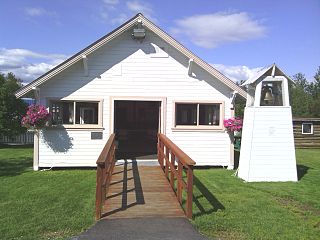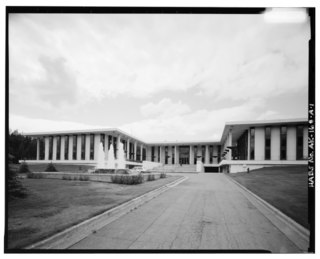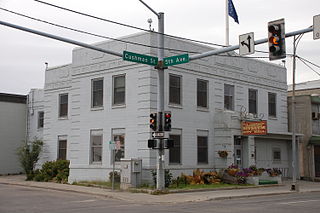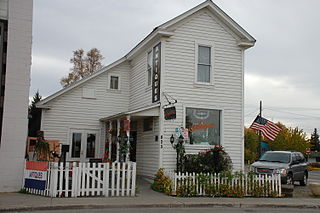
The New Jersey Historical Society is a historical society and museum located in Newark, Essex County, New Jersey, United States. The Historical Society is housed in the former headquarters of the Essex Club. It has two floors of exhibition space, a gift shop, and a hall for lectures. The NJHS offers occasional Newark walking tours. The Society formerly published the academic journal, New Jersey History.

San Diego Air & Space Museum is an aviation and space exploration museum in San Diego, California, United States. The museum is located in Balboa Park and is housed in the former Ford Building, which is listed on the US National Register of Historic Places. SDASM was established by articles of incorporation on October 12, 1961, and opened to the public on February 15, 1963.

The Cunningham-Hall Model PT-6 was an American six-seat cabin biplane aircraft of the late 1920s and was the first design of the Cunningham-Hall Aircraft Corporation of Rochester, New York.

Fort Abercrombie State Historical Park, also known as the Fort Abercrombie State Historic Site, is an Alaska state park on Kodiak Island, Alaska. It includes 182 acres (74 ha) of land at the end of Miller Point, located on the eastern shore of Kodiak Island northeast of the city of Kodiak. The park, established in 1969, is noted for its historical World War II fortifications and its scenery, which includes bluffs overlooking the ocean, spruce forests, and meadows. The site was named in honor of the early Alaska explorer and United States Army officer Lt. Col. William R. Abercrombie. The fortifications, whose surviving elements include gun emplacements, underground magazines, and foundational remnants of buildings, were built in 1941 and abandoned after the war ended, having seen no action.

The Sitka Naval Operating Base and U.S. Army Coastal Defenses are the surviving elements of the World War II-era defenses and defense establishments in and around Sitka, Alaska. These facilities, in particular the airfields and naval bases, played a key role in the defense of Alaska, and in military operations against Japanese forces which occupied Attu and Kiska, two remote islands in the Aleutian chain. The Sitka facilities were designated a National Historic Landmark in 1986.

Anchorage Depot, also known as Alaska Railroad Depot, is the railroad station at the center of the Alaska Railroad system at the junction of the two main lines their trains run on. It serves as the starting point for many tourists traveling on the luxury trains such as the Denali Star. The station is a Moderne-style three story concrete building, built in 1942 and enlarged in 1948.

The Sharlot Hall Museum is an open-air museum and heritage site located in Prescott, Arizona. Opened in 1928 by Sharlot M. Hall as the Gubernatorial Mansion Museum, the museum that now bears her name is dedicated to preserving the history and culture of the Central Highlands of Arizona.

The Cooper Landing Post Office, formerly known as Jack Lean's Store, is a historic building located in the town of Cooper Landing, Kenai Peninsula Borough, Alaska. Cooper Landing was established after prospector Joseph Cooper discovered gold in the 1880s where the Kenai River meets Kenai Lake. The chalet-style building was built c. 1910-20 as a simple log cabin, and was enlarged in the 1920s and 1930s, probably not acquiring its distinctive facade until the 1930s. Its facade is adorned with hunting trophies such as caribou and moose antlers. The building has been relocated a short distance to the west, along with the historical Ridderford School, and is now part of the Cooper Landing Historical Museum.

The Strickland Road Historic District of Greenwich, Connecticut is a 9-acre (3.6 ha) historic district that was listed on the U.S. National Register of Historic Places in 1990. The district extends along Strickland Road in the Cos Cob section of Greenwich, between its junction River Road in the south, to just north of its junction with Loughlin Road in the north. It represents a well-preserved cross-section of residential architecture dating coverint a 200-year period, from about 1740 to 1934. It includes the c. 1730 Bush-Holley House, a historic house museum which is a National Historic Landmark for it role in the Cos Cob art colony. There are 28 primary contributing buildings in the district. Most of the buildings are wood-frame structures between one and three stories in height; the notable exceptions are two of the later houses, which are Tudor Revival in style and have brick and stucco exteriors.

The Immaculate Conception Church is a historic church and former cathedral at 115 N. Cushman Street in Fairbanks, Alaska, United States.
The Whitney Section House, also known as Whitney Station, is a historic railroad-related building in Wasilla, Alaska. It is a single-story wood-frame structure, which was built in 1917 by the Alaska Railroad. It originally stood at mile 119.1, about 4.8 miles (7.7 km) north of Anchorage Station, and was one of a series built by the railroad and located at roughly ten-mile intervals. The area where it stood was taken by the federal government for Elmendorf Air Force Base, and was rescued from demolition by the local chapter of the National Railroad Historical Society. It now stands on the grounds of the Alaska Museum of Transportation and Industry in Wasilla, and has seen a variety of uses.

The Nenana Depot, located at 900 A Street in Nenana, Alaska, is an Alaska Railroad depot built in 1922. The station served an extension of the railroad which was laid in 1916. An addition was placed on the station in 1937 to house the station agent. The station has served both as an important part of the railroad's northern operations and as a terminal for its riverboat service on the Yukon River. It was listed on the National Register of Historic Places in 1977.

The Wasilla Elementary School, located near the corner of East Swanson Avenue and North Boundary Street in Wasilla, Alaska is a historic one-room school that was built in 1917. It was Wasilla's first school, and served as its primary school until 1934 when a larger school was built. It is 22 by 36 feet in dimension. It was moved to its present location, in a historic park, shortly before its NRHP nomination in 1979. It had been located about three blocks away. After 1934 it was used again as a school overflow classroom and it also served as a community hall and for weddings, funerals and other events; it served as a Church of Christ for a number of years.

Pilgrim 100-B N709Y is one of a few surviving aircraft from the early days of aviation in the history of Alaska. It is a single-engine aircraft, built as a Fairchild 100 Pilgrim in 1932 by the American Airplane & Engine Corporation, of a type where only 10 were produced. This aircraft, and others like it, were used in the early days of Alaskan aviation to transport mail, people, and supplies, to all corners of the territory. At the time of its listing on the National Register of Historic Places in 1986, it was the last Pilgrim that was still flightworthy and was stationed in Dillingham Airport. It was acquired in 2001 by the Alaska Aviation Heritage Museum, which moved it to its actual location and uses it as a flying exhibit.

The Juneau-Douglas City Museum is located at the corner of 4th and Main, opposite the Alaska State Capitol in Juneau, Alaska. It occupies a building which was built in 1950–51 to house the Juneau Memorial Library. It is a two-story Classical Revival structure built out of concrete with red marble trim elements. A gable-roofed projecting section at the center of the long wall provides the main entrance, which is recessed in an opening the full height to the pediment. This projecting section is flanked by banks of five metal-framed awning windows. The northeast facade has a gable pediment similar to that of the entry projection, below which is a large rectangular window, behind which a stained glass decoration has been installed. The building served the city as its library until the 1980s, at which time it was repurposed to house the city museum.

The Atwood Campus Center is the student center of Alaska Pacific University in Anchorage, Alaska. It is a two-story square building 113 feet (34 m) on each side, elevated on a podium extending ten or more feet to each side. It is flanked by two residence halls, which, although also 25 feet (7.6 m) in height, have three stories. This complex was designed by Edward Durell Stone and built in 1966, when the school was known as Alaska Methodist University. This complex has been listed on the National Register of Historic Places for its significance as the site of a major 1971 conference of more than 600 Alaska Native representatives, at which they formally accepted the Alaska Native Claims Settlement Act, landmark legislation which fundamentally altered the handling of land ownership and use in the state, particularly with respect to native title, which had long clouded many real estate transfers.

The Old City Hall, now the Fairbanks Distilling Company, is a historic civic building at 410 Cushman Street in Fairbanks, Alaska. It is a two-story Art Deco structure, built out of reinforced concrete in 1935 as a fireproof alternative to the city's previous city hall. The building is roughly T-shaped, with quoining patterns incised in the corners and bands of decoration on a parapet level. The building was originally built to house city offices as well as police and fire stations; the entrances to the fire equipment bays on Cushman Street have been filled in with wood framing and siding. The building was enlarged by extensions to the rear twice, once before 1950, and once after the 1967 floods. The city moved its offices to the adjacent Main School in 1994; the building then housed the Fairbanks Community Museum until it was acquired by Fairbanks Distilling Company in July 2014.

Libby's No. 23 is a historic sail-powered fishing vessel, now on display at the Lake Clark National Park and Preserve visitors center in Port Alsworth, Alaska. Built in 1914, she served in the salmon fishery of Bristol Bay until about 1951, owned by the Libby's cannery and worked by two-man crews. She is 29 feet 6 inches (8.99 m) long, with a beam of 9 feet 2 inches (2.79 m) and a depth of 4 feet (1.2 m). Its bow and stern are roughly the same shape, giving the style its name. Despite its use for freight and recreation between 1953 and 1997, the boat has retained much of its original equipment, and was fully restored by the National Park Service between 1998 and 2005, acquiring replacement parts from similar boats and removing an added motor. It is normally rigged with a mainsail and spritsail, but these are only raised when the boat is taken out of its custom-built boathouse.

The Oddfellows House, also known as Oddfellows Hall, is a former fraternal clubhouse of Oddfellows at 825 1st Avenue in Fairbanks, Alaska. It is a wood-frame building with two sections, the front one a narrow two-story structure, the rear one a wider single-story structure. Each section has its own gable roof, although they do briefly align. The building was built in 1907 by Madame Renio, a fortune teller, and initially housed a clinic and residential space in the front and a bathhouse in the rear. The bathhouse business failed after its pipes froze in the winter of 1909–10, and the building was purchased by the local chapter of the International Order of Odd Fellows (IOOF). This fraternal organization converted the front space into a kitchen and bathroom, and the rear was converted into a large meeting hall. Under the IOOF's ownership the hall was used by a wide variety of civic and religious organizations, including its sister organization, the Golden North Rebekahs. The IOOF chapter was inactive between the late 1930s and 1945, but the Rebekahs continued to maintain the building, eventually taking ownership in 1967. The Rebekahs disbanded in 2007, and the space was briefly used as a museum; it now houses a retail establishment.

The Morristown District, also known as the Morristown Historic District, is a historic district in the town of Morristown in Morris County, New Jersey. It was added to the National Register of Historic Places on October 30, 1973, for its significance in architecture, communications, education, military, politics, religion, social history, and transportation.






















